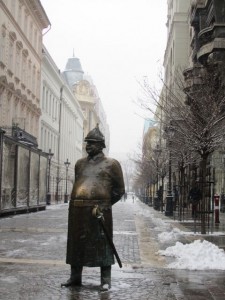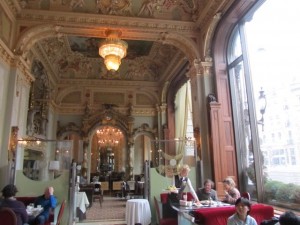Fairy Godmothers: Part II
Our train pulled out of Vienna’s Hauptbahnhof and into thick flurries that painted the landscape white. We were heading East to Budapest in a Hungarian train, chosen over the more frequently scheduled and modern Austrian trains for its food. Yes, there are still a few places in the world where dining cars serve real food, good food, and in semi-elegant settings.
My stepmother, via her European hairdresser, had clued me in on this little-known fact years ago, and Dagmar knew exactly what I was talking about. Hence, we spent our 3-hour trip nestled into plush, red velvety chairs enjoying hot Goulash soup and nibbling on Palascinta—Hungary’s take on crepes. (Ours were stuffed with cottage cheese and apricot jam, powdered sugar sprinkled on top.)
The flat, snow-covered plains, dotted with distance farmhouses, reminded me of Doctor Zhivago–the part where Yuri and his family also take a train trip East. They were escaping the Red Army, enduring many hardships along with way, I was cozy and warm and indulged in a piece of surprising good apple strudel.
I had visited Budapest before, in 1987, at the end of a month-long Eurail adventure when I was studying in Germany. I arrived with a classmate on an overnight train. We had stopped frequenting youth hostels—too expensive. Sleeping on trains instead, we planned the following day’s itinerary based on two things: a train’s occupancy (would we be able to stretch out) and the potential hours of sleep before arriving at our destination.
For example, if a train were going to Zurich, but only allowed us 5 hours sleep—pass. And then if the following train was headed to Salzburg, giving us 7 hours, but the compartments were mostly full, we’d also pass. But eventually a train would arrive offering 9 hours until Dortmund, with empty compartments…and score! Our creative trip planning took us places we never imagined…or really cared to visit.
Budapest, though, was different. We really wanted to see it, at least spend one night there, but we had completely run out of money. Luckily, my friend’s mother had given her a credit card for emergencies and she still hadn’t used it—not even once in 7 months. So we declared a state of emergency. When the local tourist office said that only one hotel, the luxurious Hilton on the Danube, accepted credit cards, we walked all the way there and got a room. What else were penniless girls suppose to do?
After taking our first shower in days–a prerequisite if you’re going to mingle with other guests at the Hilton, we headed into the streets, past the famed coffeehouses, but with no money for cake, not even coffee. I never got to go inside and see the splendor (or partial splendor, since it was the Communist Era), but I promised myself that one day I would return and eat as much cake as I wanted. Yes, one day, I too, would have a credit card and could spend money I didn’t actually possess.
The next day we left Budapest and headed to Slovenia to meet my then boyfriend, but not before partaking in the Hilton’s breakfast buffet, where we emptied out our purses and filled them with an array of fresh fruit, ham, cheese and rolls—I remember lots of rolls. It was basic survival–we had no idea where our next meal was coming from.
We arrived to Ljubljana on an overnight train the day of a major devaluation in Yugoslavia’s currency. Driving us to his parent’s house, my boyfriend gave me a wad of bills to throw out the window. (Everyone was doing it—the money no longer had any real value.) So, after days of having no hard currency, we now had so much that we threw it out the window–bill by bill, driving along a major street with pieces of worthless printed paper whirling in the air. I must admit it was quite liberating.
But now, let’s return to Budapest, 2 days after the Ball, where I awoke to a snow-covered square and devoured a hearty breakfast at the Gerloczy Café, featuring sweet, yet mildly spicy, yellow wax peppers accompanied by local prosciutto and vegetable-studded scrambled eggs.
On this second trip, I indeed spent my days hanging out in (now refurbished) Belle Époque cafés, marveling at fresco-painted ceilings, and sampling traditional Hungarian cakes. There was the Dobostorta with its thin layers of sponge cake sandwiched between slatherings of chocolate buttercream, topped with caramel, and the Esterhazy Torte–five layers of almond meringue, each covered in cognac-spiced buttercream, and iced with fondant, its signature circular, striped chocolate pattern adorning the top. Both cakes were created in the late 1800s and were favored by the Austro-Hungarian Monarchy. Their popularity has not waned since.
There were more bowls of paprika-infused Goulash. Did you know Goulash is always served as a soup? Its thick, rich broth sometimes begs for rice or pasta, but only Americans seem to listen, spooning it on top of buttery noodles—a fate frowned upon in Hungary.
With snow still falling, the fourth day in a row, we went to the turn-of-the-century Szechenyi Baths and sat outside in a large, opulent pool. Steam rose from the warm water, enveloping swimmers and soakers alike, making it difficult to see people just a few feet away. When it was time to leave, I ran back inside, barefoot in a bikini through a foot of snow.

A hidden treasure–the Book Café is located on the second floor of the former Paris Department Store.
Budapest was worth the wait. It’s a step back in time, a window into the Gilded Age. And yes, on the way back, we sat in the dining car and nibbled on more Palascinta served by a bow tie-clad waiter. (This time they were stuffed with almonds and drizzled with chocolate.) The fields were still painted white, the velvety chairs still comfy, but the best part of the trip back was knowing that I didn’t have to sleep on the train.
Tags: Bookcafé, Budapest, delicious expeditions, Gerloczy Café, kris rudolph, New York cafe budapest, Palascinta, train to Budapest, Vienna to Budapest







